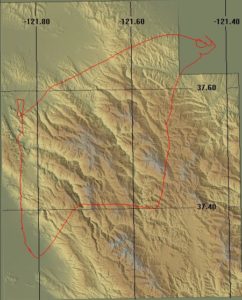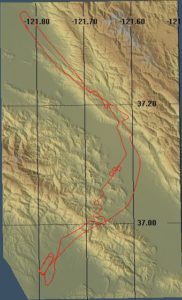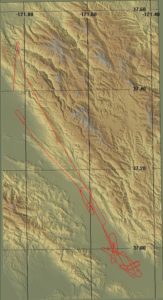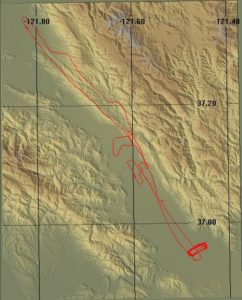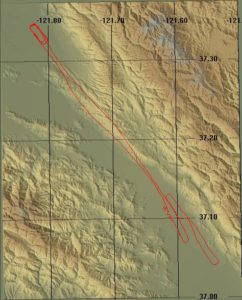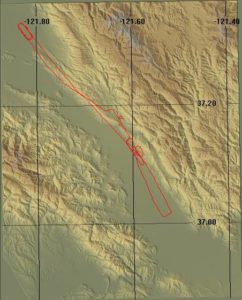I spent an hour last Sunday with Grainne going over N4754D’s maintenance logs making sure I could find everything and getting my final endorsement for the practical test. Grainne called Mike Shiftlett the Pilot Examiner who is going to do my checkride and I was given Paso Robles as my cross country destination – that was lucky, my long cross country was to San Luis Obispo and I flew right over Paso Robles so I can reuse most of the flight plan. Mike is a senior CFI over at Nice Air, he has his own web site at www.checkrides.com which has a lot of useful info on the usual dumb mistakes and how he typically conducts a checkride. Grainne had told me about this last week so I read through everything he had to say and we took some time to make sure all the documents, endorsements and logged hours were correct and in line with his requirements. I had booked flying time with Grainne on Saturday and Sunday and solo time on Monday, but the weather has just closed in, so I haven’t flown since the 8th, not a great lead in to the checkride.
So the big day has arrived, exactly 99 years since the Wright brothers flew for the very first time, what a great day to gain your Private Pilots License! what a pity then that winter had finally arrived in the Bay Area and the weather sucks.
I arrived early to get a briefing from DUATS, it sucked. Ceilings of 2000~4000’ forecast all the way down the coast, embedded thunderstorms and a freezing level at 4000’ with intermittent rain showers. You might be able to fly, but only by staying low and playing dodge with rain clouds and always having a handy airport to land at quick if the weather closed in – so an easy choice that I wouldn’t fly today. The test was supposed to start at 10am, but Mike called about 9:30am to ask if I wanted to fly (nope), then he said we could just complete the oral part of the test today and at least get that finished. This sounded fine and he said he would come over at 11:30am instead. This was just as well because as I put the phone down I realized that I had forgot to bring my checkbook to pay the exam fee and I had to drive home to get it (not having $350 in cash in my back pocket).
I got back to Tradewinds about 10:30am and spent some time going over bits and pieces in the FAR and various other things I thought I’d screw up. I was just in the middle of asking Yoed (a Tradewinds CFI I’ve flown with a couple of times) about some tricky class E/class G airspace boundaries over the Serria’s when Mike turned up. He was pretty relaxed and asked what my question was, joking that he could check if Yoed got the answer right (he did). He spent some time talking with Yoed about IFR stuff in Europe, apparently Mike spent time training RAF pilots in the UK, and telling us about the book he had just written called “Fitness for Pilots”. All in all he comes across as the total Californian dude, head-set in one hand, surf board in the other. Finally, we got settled down to start the test.
He started by explaining exactly how the test would be conducted. The various options on how it could end (pass, fail or discontinue) and then checking my eligibility – all the various endorsements and logged hours. Grainne was on hand, which was just as well because she had to go fill out some stuff on logged ground school hours and stick it in my log book. Once he had checked everything, he asked for a $150 fee, I’ll have to pay the other $200 when we get to do the practical test. We started with the planes maintenance logs, although he explained we would have to do this again when I actually flew to make sure the plane was airworthy. He asked questions on when all the required inspections needed to be carried out, the Annual, 100-hr, ELT, Pitot-Static and Transponder. The only one I missed was how often the ELT needed inspections, I said I thought every it was 24 months and he said “do you want to check the FAR before you make that your final answer”, I checked and of course it was every 12 months. In general, he said anything you didn’t actually have to know in the plane, you could look up. I remember he asked questions about the planes systems, what was the suction pump for, what would happen to the engine if the master switch was turned off and what instrument would fail if the pitot tube was blocked. He asked some aero-medical questions like what are the symptoms of hypoxia and what would you do if a passenger was hyperventilating. He asked what color the lights on a sides and far end of a runway were at night and what color taxi way lights were. He asked about night currency for carrying passengers, and he asked if the 3 landings were to a full stop or would touch and goes be ok and what time would the landings need to be performed at. He pulled out a chart and asked me to identify al the various airspace types and about the various VFR minimums for each and about SVFR requirements. He picked an airport and asked me to tell him everything I could read from the chart about that airport. He asked what would happen if a piece of equipment failed, this was kind of open ended and we got into a discussion about the minimum equipment requirements, the required equipment in the POH, marking it INOP, the only bit I missed and had to look up in the FAR, is that the piece of equipment must be deactivated as well, he also asked if I could simply remove it, I said not without invalidating the weight and balance. He didn’t check my flight plan to Paso Robles in great detail, but he did ask where I got the TAS from, I said de-rated from the POH figures which was the right answer, he said many folks say “my CFI told me” or “my rule of thumb is…”. He asked about Vx and Vy, what they were for my plane, as a “bonus” question he asked if a headwind would effect the time to climb to a particular altitude, which I got right (no effect).
And that was it. He told me I had passed with no problems, it really was easier than I was expecting and all in all it took just slightly longer than an hour. He gave me a “Letter of Discontinuance” due to the weather, as long as I get the practical test done inside 60 days I’m done with the oral part. I’ve got a date of January 20th scheduled for the checkride flight and I’m on his waitlist if a slot opens up earlier. I’m going back to Ireland on Sunday for a 2 week Christmas holiday, so I’ll be back in San Jose on January 6th ready and waiting to fly some more and try and get sharp for the checkride. Grainne emailed me later and told me it was one of the shortest tests she’d every seen Mike do and that he could see I really knew my stuff.

